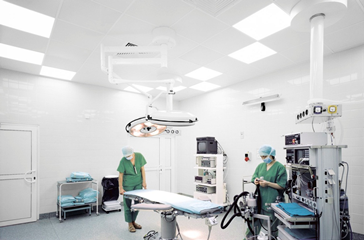
This summer the 24th International Congress on Sound and Vibration (ICSV24) was held in London (23 – 27 July 2017). I already published a general blog post about it, and one post about office acoustics highlights (here). In this one, I dig into the world of healthcare acoustics.
Below I compiled shortly the main content from the various healthcare-related ICSV London conference presentations and papers. My intention is to gather new knowledge of healthcare acoustics, thus facilitating for the Acoustic Bulletin readers who have this particular interest. All ICSV conference abstracts can be found here.
DESIGN CONSIDERATIONS FOR IMPROVEMENT OF SPEECH INTELLIGIBILITY AND PRIVACY IN A HOSPITAL INTENSIVE CARE UNIT (paper 698)
Sentagi Sesotya Utami, Ressy Jaya Yanti, (Indonesia)
Joko Sarwono, Randy Frans Fela, Iva Rofiatun Nisa Azzahra (Indonesia)
Acoustic problems that mainly occur in an Intensive Care Unit (ICU) are noises from medical staff activities and equipment. Excessive sound from human conversation and activities is considered unwanted noise. The nurse station is the location where the noise produced from the conversation will rise significantly and where lack of speech privacy.
This research is based on computer modeling that enables the inclusion of scattering effects. By principle, the acoustical treatment in a nurse station is to avoid speech leakage from this area as well as to improve speech intelligibility.
Design improvement did not create a significant impact. The subjective evaluation also confirms this finding since no association is found between the objective parameters of speech intelligibility, SPL (loudness), C50 (clarity for speech), and T30 (reverberation). Hanging *abfussor at the nurse station ceiling created the most difference from the existing condition (baseline).
*Abfussor is a term for an acoustic panel that can behave as both an absorber and diffuser. This treatment is chosen since the intention is to reduce excessive noise while reflecting the wanted sound (speech) to a certain direction that is towards the nurse station area only.

NOISE LEVELS AND NOISE SOURCES IN THE OPERATING THEATRES (paper 1003)
Weifan Liu, Hui Xie, (China)
Operating theatres should provide sterile and quiet work environments for patients and medical staff and the aim of this paper is to reveal the noise levels and noise sources here. A total of 20 operations were measured in three departments of a hospital, namely orthopedics, gynecology, chirurgery. Based on actual measurements and behavior observations, the results showed that the Leq of surgeries in three departments ranged from 42.2 dBA to 94.6 dBA.
The main noise sources were talking, door opening and closing, and surgical instruments. Gynecology surgeries have the unique noise source of baby crying. Analysis of the noise sources shows that sound sources are partially avoidable. The next step of this project is to study on noise control strategies in the operating theatres.
ASSOCIATIONS OF ACOUSTIC ENVIRONMENT WITH PHYSIOLOGICAL AND PSYCHOLOGICAL STATES AMONG HOSPITALIZED PATIENTS IN GENERAL HOSPITAL WARDS (paper 1005)
Zhixiao Deng, Jian Kang (United Kingdom)
Hui Xie (China)
Hospital wards are supposed to provide a safe and quiet environment for patients’ treatment and recovery. However, noise levels in most hospitals across the world have exceeded the limit of relevant standards. To test whether excessive noises have negative influence in the rehabilitation of patients, 60 eligible participants were recruited during their hospitalized treatments in a general hospital in China. They were randomly allocated to the normal ward and acoustically refurbished silent ward, with the same geometry and appearance.
Improvement of the acoustic environment in the acoustically refurbished silent ward was done with sound-absorbing ceiling and sound-insulating doors and windows. Reverberation time dropped by 47% and the Leq (noise levels) decreased by 5.2 dBA during night-time in the silent ward.
Patients’ sleep quality improved due to more sufficient sleep time with less noise disturbance in the silent ward. The mean heart rate of patients was significantly and positively correlated with noise level in the ward. The increasing of equivalent sound level and impulsive peak noise level was significantly associated with mean value of heart rate in both daytime and night time. Therefore, a silent ward condition would be beneficial for hospitalized patients.
A REVIEW OF THE EFFECTIVENESS, PRACTICAL IMPLICATIONS AND IMPACT OF GUIDELINES ON ACOUSTIC CONDITIONS IN UK HEALTHCARE PREMISES (paper 1049)
Richard Budd (United Kingdom)
This paper includes a review of the NHS guidance on acoustics and vibration in healthcare premises, Health Technical Memorandum 08-01. In the 8 years since its first publication, the document’s recommendations have become part of the UK’s healthcare estate standard suite of technical guidelines. Its advice has also been incorporated to BREEAM assessment guidelines for improving the internal and external acoustic environment of health building projects.
HTM 08-01 superseded a more acoustics-focused document (HTM2045). Creating a more readily achievable set of criteria, and adopting a more practical approach, the understanding and implementation of acoustic considerations in healthcare design has been increased.
The paper discusses how this has improved the acoustic environment, working conditions and healing capabilities for patients in projects across the UK. It will also review the innovation in product design that it has helped drive, and give thoughts on where improvements to the guidance could be made.


